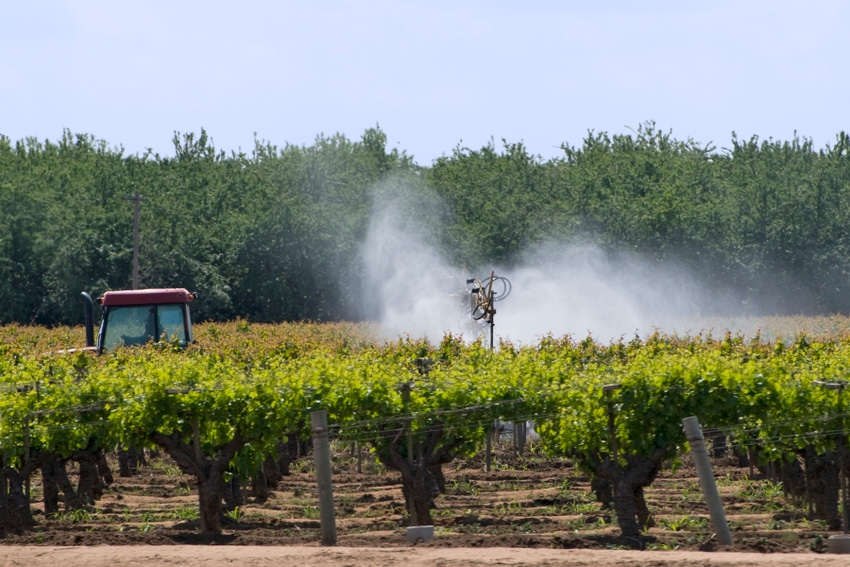
Ready or not, California growers will soon have to go entirely without chlorpyrifos, a pesticide that has faced increasing state and federal scrutiny as an air contaminant.
The state Department of Pesticide Regulation today announced its intent to ban chlorpyrifos within two years if not sooner. The move follows the pesticide's formal designation in April as an air pollutant that could be hazardous to human health.
Chlorpyrifos is used to control pests on a variety of crops, including alfalfa, almonds, citrus, cotton, grapes and walnuts, although its use has greatly declined in the past decade. The state Environmental Protection Agency and Department of Food and Agriculture promise that Gov. Gavin Newsom's revised budget proposal, due out this month, will include $5.7 million to support the transition to safer, more sustainable alternatives.
Newsom also plans to convene a working group to identify, evaluate and recommend alternative pest management solutions, officials say. The funding must be approved by the Legislature.
"It's definitely going to be a challenge for some growers who find it very difficult to find an alternative method to deal with pests," DPR spokeswoman Charlotte Fadipe tells Western Farm Press. "We do believe it's time for this chemical to be put to bed.
""It's a move we have to make," she says.
Use has declined
Growers' use of chlorpyrifos in California dropped more than 50 percent from two million pounds in 2005 to just over 900,000 pounds in 2016, according to the DPR's most recent statistics. Grower use has waned as the state has placed stricter controls on the pesticide, which acts as a contact or stomach poison to pests.
In 2015, DPR designated chlorpyrifos as a “restricted material” that requires a permit from the county agricultural commissioner for its application. In addition, applications of chlorpyrifos must be recommended by a licensed pest control advisor and supervised by a licensed certified applicator.
In April, chlorpyrifos was formally listed as a “toxic air contaminant," which California law defines as “an air pollutant which may cause or contribute to an increase in mortality or an increase in serious illness, or which may pose a present or potential hazard to human health.” The listing requires DPR to develop control measures to protect the health of farmworkers and others living and working near where the pesticide is used, the agency explains in a news release.
The proposed cancellation of permits would affect dozens of agricultural products containing the pesticide, state officials say. Chlorpyrifos has been prohibited by the U.S. Environmental Protection Agency for residential uses since 2001.
Several states have moved to ban chlorpyrifos on farms after the U.S. Environmental Protection Agency reversed an earlier effort to phase out the chemical nationally. Responding to a legal challenge by farm labor and environmental groups, a federal appeals court ordered the EPA to reconsider again and come out with a decision by July.
In the meantime, Hawaii is phasing out chlorpyrifos by 2023 and New York legislators just passed a bill to eliminate the chemical by 2021, Fadipe notes.
Bans could hurt farmers
DowDuPont, which produces chlorpyrifos, criticizes efforts to curb its use and asserts the bans will hurt farmers who rely on it to control insects, according to The Associated Press.
Indeed, while many pests have responded to alternative treatments, almond growers have complained that no other tool but chlorpyrifos will work against leaffooted plant bugs and stink bugs, which feed on and damage developing nuts.
The working group convened by the DPR and CDFA will identify and develop safer and more practical and sustainable alternatives to chlorpyrifos, including the use of biological controls and other integrated pest management practices. They will also work with growers who are struggling to make the transition, officials say.
The $5.7 million in Newsom's budget proposal would facilitate research and technical assistance to support the transition, the agencies explain. The agencies and the working group will seek both short-term and long-term alternatives, the release states.
“We look forward to working with the Legislature through the budget process on the Governor’s proposal to support growers in the transition to alternative pest management,” says CDFA Secretary Karen Ross.
About the Author(s)
You May Also Like






